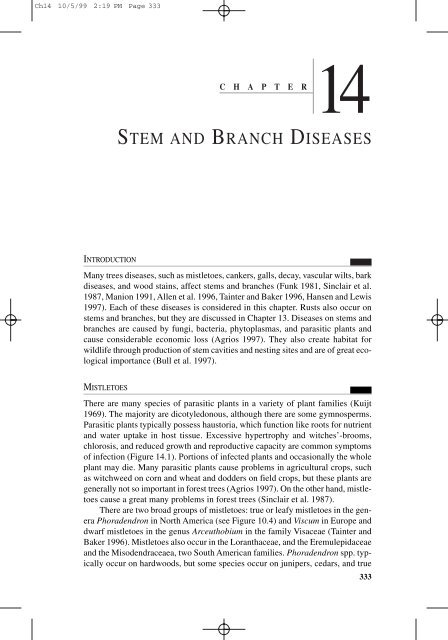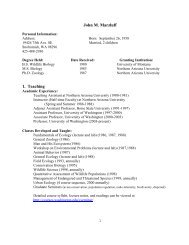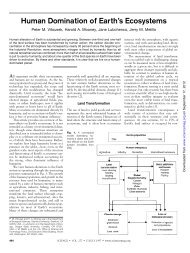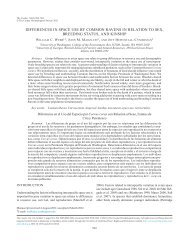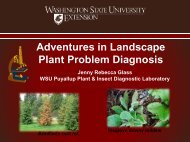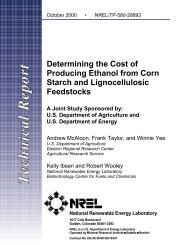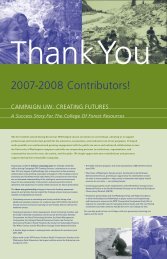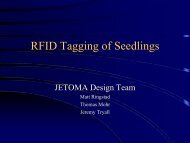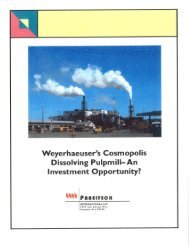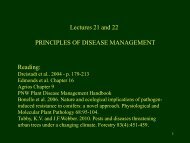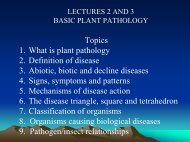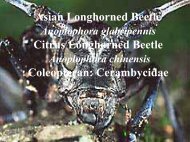You also want an ePaper? Increase the reach of your titles
YUMPU automatically turns print PDFs into web optimized ePapers that Google loves.
Ch14 10/5/99 2:19 PM Page 333<br />
INTRODUCTION<br />
C H A P T E R14<br />
<strong>STEM</strong> <strong>AND</strong> <strong>BRANCH</strong> <strong>DISEASES</strong><br />
Many trees diseases, such as mistletoes, cankers, galls, decay, vascular wilts, bark<br />
diseases, and wood stains, affect stems and branches (Funk 1981, Sinclair et al.<br />
1987, Manion 1991, Allen et al. 1996, Tainter and Baker 1996, Hansen and Lewis<br />
1997). Each of these diseases is considered in this chapter. Rusts also occur on<br />
stems and branches, but they are discussed in Chapter 13. Diseases on stems and<br />
branches are caused by fungi, bacteria, phytoplasmas, and parasitic plants and<br />
cause considerable economic loss (Agrios 1997). They also create habitat for<br />
wildlife through production of stem cavities and nesting sites and are of great ecological<br />
importance (Bull et al. 1997).<br />
MISTLETOES<br />
There are many species of parasitic plants in a variety of plant families (Kuijt<br />
1969). The majority are dicotyledonous, although there are some gymnosperms.<br />
Parasitic plants typically possess haustoria, which function like roots for nutrient<br />
and water uptake in host tissue. Excessive hypertrophy and witches’-brooms,<br />
chlorosis, and reduced growth and reproductive capacity are common symptoms<br />
of infection (Figure 14.1). Portions of infected plants and occasionally the whole<br />
plant may die. Many parasitic plants cause problems in agricultural crops, such<br />
as witchweed on corn and wheat and dodders on field crops, but these plants are<br />
generally not so important in forest trees (Agrios 1997). On the other hand, mistletoes<br />
cause a great many problems in forest trees (Sinclair et al. 1987).<br />
There are two broad groups of mistletoes: true or leafy mistletoes in the genera<br />
Phoradendron in North America (see Figure 10.4) and Viscum in Europe and<br />
dwarf mistletoes in the genus Arceuthobium in the family Visaceae (Tainter and<br />
Baker 1996). Mistletoes also occur in the Loranthaceae, and the Eremulepidaceae<br />
and the Misodendraceaea, two South American families. Phoradendron spp. typically<br />
occur on hardwoods, but some species occur on junipers, cedars, and true<br />
333
Ch14 10/5/99 2:19 PM Page 334<br />
334 CHAPTER 14<br />
Figure 14.1<br />
Excessive brooming on a ponderosa<br />
pine tree in eastern Oregon caused by<br />
western dwarf mistletoe (Arceuthobium<br />
campylopodum).<br />
firs. Typically true mistletoes do not occur north of 40 to 45 ° north latitude (i.e.,<br />
across the United States from Oregon to New Jersey). They have well-developed<br />
stems with leaves 2.5 to 5 cm long. Seeds are disseminated by birds feeding on<br />
their berries. Infected branches typically have galls and brooms. True mistletoes<br />
can be managed by branch pruning and spraying where the value of trees is very<br />
high, such as fruit trees.<br />
Dwarf misletoes are a particular problem in western North America, infecting<br />
Douglas-fir, pines, firs, spruces, hemlocks, and western larch (Hawksworth and<br />
Wiens 1996). They occur from Mexico northward to Canada and across Canada<br />
to the northeastern United States. Species and hosts are listed in Table 14.1. At least<br />
47 species are known from Central and North America, Europe, Africa, Asia, the<br />
Azores, and Caribbean Islands. Many are host-specific, like Douglas-fir dwarf<br />
mistletoe, but some occur on several hosts. For example, A. campylopodum<br />
occurs on Jeffrey and ponderosa pines, and A. tsugense subsp. tsugense occurs on<br />
western hemlock, true firs, and lodgepole pine.<br />
Arceuthobium spp. are dioecious plants without true leaves. A typical life<br />
cycle is shown in Figure 14.2. Seed dispersal normally occurs in the later summer<br />
or fall. Local dispersal occurs when seeds are shot from mistletoe plants at<br />
velocities as high as 100 kph. Seed dispersal range is usually 6 to 11 m, but some<br />
seeds may travel as far as 15 m. Birds or rodents are capable of carrying seeds long<br />
distances to initiate new infection centers. Seeds have a viscous coat, enabling<br />
them to stick on the host. They commonly overwinter on needles and germinate<br />
in the spring. The radicle produced by the seed grows until it reaches a suitable<br />
bark crevice, bud, or needle base. A holdfast forms that completes the infection<br />
process by wedging into the host tissues and producing an extensive haustorial<br />
absorptive system. These “sinkers” penetrate the xylem of the host and are subsequently<br />
embedded by additional growth of xylem tracheids to which they are<br />
connected. Infected branches are typically swollen and distorted and are commonly<br />
called witches’-brooms. Infections may be localized or systemic.
Ch14 10/5/99 2:19 PM Page 335<br />
Fertilization<br />
megasporogenesis<br />
Pollination<br />
Developing<br />
fruit<br />
Microsporogenesis<br />
May Year 5<br />
April Year 5<br />
Plant dioecious<br />
Seed dispersal<br />
and interception<br />
by pine needles<br />
September Year 6<br />
May Year 6<br />
August Year 4<br />
Figure 14.2<br />
Life cycle of a typical dwarf mistletoe.<br />
(Source: From Hawksworth and Wiens 1996.)<br />
Summer Year 4<br />
Start September Year 0<br />
Summer Year 3<br />
First<br />
shoots<br />
October Year 0<br />
May Year 1<br />
Stem and Branch Diseases 335<br />
Summer Year 1<br />
Summer Year 2<br />
Swelling<br />
Seeds washed to<br />
twigs by rain<br />
Germination<br />
Penetration<br />
Dwarf mistletoes take up nutrients and water from their hosts as well as most<br />
of their carbohydrates, although they do photosynthesize (Hawksworth and Wiens<br />
1996). The expanding network of sinkers eventually breaks through the surface<br />
to form new aerial shoots, buds, flowers, and seeds. Aerial shoots typically range<br />
in height from 2 to 10 cm, and the branching pattern may be whorled or fanlike.<br />
Aerial shoots (Figures 14.3 and 10.3) do not emerge until the second or third year<br />
(Figure 14.2). Male and female flowers are produced on separate plants in the second<br />
year after emergence of the shoots. Male flowers have three or four “petals”<br />
that open to expose the pollen sacs, but female flowers are inconspicuous and<br />
remain closed. Most flowers are pollinated by insects. Fourteen to 18 months after<br />
pollination, the fruit, or fleshy berry, matures, with each berry containing a single<br />
seed. From infection to seed production takes 4 to 5 years. Spread is from tree<br />
to tree, and infection centers in young stands typically develop around larger and<br />
older infected residual trees.
Ch14 10/5/99 2:19 PM Page 336<br />
336 CHAPTER 14<br />
TABLE 14.1 Species of Arceuthobium, Common Names, Major<br />
Hosts and Distribution<br />
Species Common name Major hosts Major distribution<br />
A. abietinum f. White fir dwarf mistletoe Abies concolor Western United States<br />
sp. concoloris A. durangensis Mexico<br />
A. abietinum f. sp.<br />
magnificae<br />
Red fir dwarf mistletoe Abies magnifica California<br />
A. abietis-religiosae Mexican fir dwarf mistletoe Abies durangensis Mexico<br />
A. americanum Lodgepole pine dwarf<br />
mistletoe<br />
Pinus contorta Western North America<br />
A. apachecum Apache dwarf mistletoe Pinus strobiformis Southwestern<br />
United States<br />
A. aureum subsp. Golden dwarf mistleltoe Pinus montezumae Guatemala<br />
aureum P. oaxacana<br />
P. pseudostrobus<br />
A. aureum subsp. Durangan dwarf mistletoe Pinus michoacana Mexico<br />
petersonii P. montezumae<br />
P. oaxacana<br />
P. oocarpa<br />
P. patula<br />
P. pseudostrobus<br />
A. azoricum Azores dwarf mistletoe Juniperus brevifolia Azores<br />
A. bicarinatum Hispanolian dwarf Pinus occidentalis Haiti and Dominican<br />
mistletoe Repulic<br />
A. blumeri Blumer’s dwarf mistletoe Pinus ayacahuite Mexico<br />
A. chinense Keteleeria dwarf mistletoe Keteleeria evelyniana China<br />
A. californicum Sugar pine dwarf mistletoe Pinus lambertiana California<br />
A. campylopodum Western dwarf mistletoe Pinus ponderosa<br />
P. jeffreyi<br />
Western North America<br />
A. cyanocarpon Limber pine dwarf Pinus flexilis Western North America<br />
mistletoe P. albicaulis<br />
P. longaeva<br />
A. divaricatum Pinyon dwarf mistletoe Pinus edulis Southwestern<br />
P. monophylla United States<br />
A. douglasii Douglas-fir dwarf mistletoe Pseudotsuga menziesii Western North America<br />
Texas, Mexico<br />
A. durangense Durangan dwarf mistletoe Pinus douglasiana<br />
P. michoacana<br />
P. pseudostrobus<br />
Mexico<br />
A. gillii Chihuahua pine dwarf Pinus herrerai New Mexico<br />
mistletoe P. lumholtzii Mexico<br />
A. globosum Rounded dwarf misteltoe Pinus maximinoi<br />
P. patula<br />
P. teocote<br />
Mexico<br />
A. guatemalense Guatemalan dwarf<br />
mistletoe<br />
Pinus ayacahuite Guatemala, Mexico<br />
A. hawksworthii Hawksworth dawrf<br />
mistletoe<br />
Pinus caribaea Belize<br />
A. hondurense Honduran dwarf mistletoe Pinus maximinoi Honduras, Mexico<br />
A. juniperi-procerae East Farican dwarf<br />
mistletoe<br />
Juniperus procera Kenya, Eritrea, Ethiopa<br />
A. laricis Larch dwarf mistletoe Larix occidentalis Oregon, Washington,<br />
Tsuga mertensiana Idaho, Montana, British<br />
Columbia<br />
A. littorum Coastal dwarf mistletoe Pinus muricata California<br />
P. radiata<br />
(continued)
Ch14 10/5/99 2:19 PM Page 337<br />
TABLE 14.1 (concluded)<br />
Stem and Branch Diseases 337<br />
Species Common name Major hosts Major distribution<br />
A. microcarpum Western spruce dwarf Picea engelmannii Arizona, New Mexico<br />
mistletoe Picea pungens<br />
Pinus aristata<br />
A. minutissimum Himalayan dwarf mistletoe Pinus densata Bhutan<br />
A. monticola Western white pine dwarf Pinus monticola California, Oregon<br />
mistletoe<br />
A. nigrum Black dwarf mistletoe Pinus lawsonii Mexico, Guatemala<br />
P. oaxacana<br />
P. patula<br />
A. oaxacamum Oaxacan dwarf mistletoe Pinus oaxacana Mexico<br />
P. lawsonii<br />
P. pseudostrobus<br />
A. pendens Pendent dwarf mistletoe Pinus discolor Mexico<br />
P. orizabensis<br />
A. pini Alpine dwarf mistletoe Pinus yunnanensis Bhutan<br />
A. pusillum Eastern dwarf mistletoe Picea mariana Mid and eastern<br />
P. glauca North America<br />
P. rubens<br />
A. rubrum Ruby dwarf mistletoe Pinus cooperi Mexico<br />
P. durangensis<br />
P. engelmannii<br />
P. herrerai<br />
P. teocote<br />
A. sichuanense Sichuan dwarf mistletoe Picea balfouriana Bhutan<br />
P. spinulosa China<br />
A. siskiyouense Knobcone pine dwarf Pinus attenuata California, Oregon<br />
mistletoe<br />
A. strictum Unbranched dwarf Pinus leiophylla Mexico<br />
mistletoe<br />
A. tibetense Tibetan dwarf mistletoe Abies forrestii China<br />
A. tsugense subsp. Hemlock dwarf mistletoe Tusga heterophylla California, Oregon,<br />
tsugense Washington, British<br />
Western Abies amabilis Columbia, Alaska<br />
hemlock race A. lasiocarpa var.<br />
lasiocarpa<br />
Shore pine race Pinus contorta var.<br />
contorta<br />
A. tsugense subsp. Mountain hemlock dwarf Tsuga mertensiana California, Oregon,<br />
mertensiana mistletoe Abies amabilis Washington, British<br />
A. lasiocarpa Columbia<br />
A. procera<br />
Pinus albicaulus<br />
A. vaginatum subsp. Pinus patula + 12 Mexico<br />
vaginatum other pines<br />
A. vaginatum subsp. Southwestern dwarf Pinus durangensis Mexico<br />
cryptopodum mistletoe<br />
subsp. vaginatum Pinus ponderosa var. Southwestern<br />
scopulorum United States<br />
A. verticilliflorum Big-fruited dwarf mistletoe Pinus arizonica Mexico<br />
P. durangensis<br />
A. yecorense Yecoran dwarf mistletoe Pinus durangensis Mexico<br />
P. herrerai<br />
P. leiophylla<br />
P. lumholtzii<br />
Source: Compiled from Hawksworth and Wiens (1996).
Ch14 10/5/99 2:19 PM Page 338<br />
338 CHAPTER 14<br />
Figure 14.3<br />
Aerial shoots of western<br />
hemlock dwarf mistletoe<br />
(A. tsugense subsp.<br />
tsugense).<br />
Dwarf mistletoes cause growth reduction, loss of host vigor, poor wood quality,<br />
branch and top kill, and even mortality (Tainter and Baker 1996). Poor-quality<br />
wood results because branch swelling and stem infections cause abnormal grain,<br />
resin impregnation, and spongy woody texture. Branch proliferation and swellings<br />
also increase the size and number of knots. Squirrels also may feed on infected<br />
branches, especially of lodgepole pine, western larch, and Douglas-fir and have<br />
caused “red flagging” in young stands in western Canada.<br />
Dwarf Mistletoe Infection Rating Scheme<br />
A 6-class dwarf mistletoe rating scheme was developed in the western United<br />
States to help foresters and researchers judge the degree of tree infection<br />
(Hawksworth 1977). This scheme, also known as the Hawksworth scheme, is illustrated<br />
in Figure 14.4. The first step is to divide the crown of individual trees into<br />
thirds (top, middle, and bottom). Then each third is rated as 0, 1, or 2 based on<br />
the degree of infection. For example, a rating of 2 is a heavy infection where more<br />
than half of the total number of branches in the third is infected. The final step is<br />
to add the ratings of the three thirds to get a rating for the total tree. The maximum<br />
rating is 6 for a very heavily infected tree.<br />
Ecological Relationships<br />
The distribution of dwarf mistletoe species is strongly influenced by topography,<br />
climate, fire, insect outbreaks, and forest succession. For example, Douglas-fir<br />
dwarf mistletoe does not occur in western Oregon and Washington. The combined<br />
effects of physiography, fire, and forest succession have apparently prevented the<br />
immigration and establishment of A. douglasii in this region. Climatic warming<br />
the last few thousand years has greatly fragmented the populations of dwarf mistletoes<br />
in the southwestern United States (Hawksworth and Wiens 1996).<br />
Wildfires seem to be the most important single factor governing the abundance<br />
and distribution of dwarf mistletoes (Hawksworth and Wiens 1996). Although<br />
high-intensity stand-replacing fires reduce dwarf mistletoe populations, other types<br />
of fires can increase populations. For example, spotty fires leave scattered, live,
Ch14 10/5/99 2:19 PM Page 339<br />
16<br />
6-Class Mistletoe Rating System<br />
Instructions<br />
Step 1: Divide crown into thirds<br />
Step 2: Rate each third 0, 1, or 2<br />
(0) No visible infections<br />
(1) Light infection ( 1 /2 or less of total number<br />
of branches in the third infected)<br />
(2) Heavy infection (more than 1 /2 of total<br />
number of branches in the third infected)<br />
Step 3: Add ratings of thirds to obtain rating for<br />
total tree<br />
Stem and Branch Diseases 339<br />
Figure 14.4<br />
The 6-class dwarf mistletoe rating scheme developed in the western United<br />
States. This scheme is known as the Hawksworth scheme.<br />
(Source: Hawksworth 1977.)<br />
infected trees that reinfect regenerating stands. In the Rocky Mountains wildfires<br />
tend to reestablish seral lodgepole pine stands, which are highly susceptible to A.<br />
americanum and limit development of climax spruce and fir species. Heavily<br />
infected lodgepole pine stands are very susceptible to fire because of dead wood<br />
and brooming.<br />
Dwarf mistletoes also can influence wildlife populations. Mistletoe brooms provide<br />
good structures for establishment of birds’nests, and the number of spotted owls<br />
nests on the east slopes of the Cascades in Oregon and Washington has increased<br />
as a result of an increase in mistletoe brooms due to active fire suppression.<br />
Management<br />
Because of extensive timber losses from dwarf mistletoes, considerable effort<br />
has been expended to manage them (Hawksworth and Wiens 1996). There are<br />
basically four ways to manage dwarf mistletoes: (1) silvicultural, (2) chemical,<br />
(3) biological, and (4) genetic resistance. Dwarf mistletoes are relatively easy to<br />
manage silviculturally because of their slow rate of spread, host restriction, and<br />
dependence on living trees for survival. Success can be nearly 100% if done correctly.<br />
Clearcutting is the most successful method, but infected residual trees must<br />
be removed. Ten well-dispersed infected trees per acre (25 trees per hectare) can<br />
potentially result in infection of all new and existing trees. Thinning may increase<br />
the incidence of dwarf mistletoe by allowing more light in a stand and stimulating<br />
the growth of existing mistletoe plants. Outbreaks of mountain pine beetle may<br />
increase the proportion of infected trees by killing uninfected trees and increasing<br />
the rate of spread of mistletoes. Thus management objectives for both beetles<br />
and dwarf mistletoes need to be taken into account.<br />
It is interesting to contrast silvicultural management on the east and west sides<br />
of the Cascade crest in Oregon and Washington. In old-growth stands on the west
Ch14 10/5/99 2:19 PM Page 340<br />
340 CHAPTER 14<br />
side of the Cascades, infection is high in western hemlock and true firs. As previously<br />
discusssed, very little mistletoe occurs on Douglas-fir in this zone. Mistletoe<br />
infections occur in patches in stands and radial spread ranges from 0.3 to 1.5<br />
m/year with significant spread from overstory to understory trees. Fire does not play<br />
an important role in the ecology of hemlock and true fir dwarf mistletoes because<br />
fires are historically so infrequent, occurring only every 200 to 400 years. However,<br />
when large fires did occur, mistletoe incidence was reduced because trees were<br />
killed. Clearcutting in this area is an effective way to control dwarf mistletoe. New<br />
ecosystem management practices, where green trees are retained for wildlife purposes,<br />
however, may increase mistletoe infection because many of the retained trees<br />
are infected with mistletoe, which can easily spread to the understory trees.<br />
On the east side of the Cascade crest, infection is low in western hemlock,<br />
but high in Douglas-fir, lodgepole and ponderosa pine, true firs, and larch. Radial<br />
spread is only 0.5 to 0.7 m/year, but there is significant spread from overstory to<br />
understory. In this region fire plays an important role in the development of dwarf<br />
mistletoes, especially in pine forests. The historically frequent low-intensity fires<br />
here killed small infected trees and reduced the rate of spread. Fire suppression<br />
has caused increased infection in these stands, and the incidence of infection is<br />
now much higher than natural levels. Clearcutting usually is not a viable management<br />
option here. Removal of infected trees will reduce infection in un–evenaged<br />
stands, but these stands must be revisited after a number of years to remove<br />
residual infected trees. Ponderosa pine dwarf mistletoe also may be managed in<br />
thinned or unthinned stands by prescribed understory burns, but scorch heights of<br />
30 to 60% of the crown length are required to significantly reduce dwarf mistletoe<br />
infections. Use of resistant species also is a viable management option.<br />
Chemical control consists of herbicides and growth regulators. Herbicides<br />
have generally proven to be unsuccessful and growth regulators have shown the<br />
most promise. The ethylene-releasing growth regulator Florel, whose active<br />
ingredient is ethephon (2-chloroethyl phosphonic acid) is the only chemical<br />
approved by the EPA for use in the United States. Use of this chemical can delay<br />
seed production by the dwarf mistletoe by 2 to 4 years, reduce the rate of mistletoe<br />
spread, and protect understory trees. However, it cannot cure infected trees<br />
since the endophytic system remains active. Ground spraying of high-value trees<br />
in recreational and residential areas has proven effective, and shoot abscission<br />
rates of 90 to 100% are possible when coverage is thorough. Helicopter spraying<br />
for extensive aerial coverage, however, has proven unsuccessful.<br />
Biological control has promise because many fungi are pathogenic on dwarf<br />
mistletoes and some insects, particularly lepidopteran larvae, feed on dwarf<br />
mistletoes. However, in practice the use of biological control seems remote.<br />
Genetic control has greater potential. In central Oregon small Pinus ponderosa<br />
seedlings produced by grafting scions from Arceuthobium campylopodum–<br />
resistant trees to root stocks were planted in a heavily infected stand. After 20<br />
years high levels of resistance were found in grafts of several selections. Evidence<br />
for host resistance to dwarf mistletoes has been noted in several host-parasite<br />
combinations.
Ch14 10/5/99 2:19 PM Page 341<br />
CANKERS<br />
Stem and Branch Diseases 341<br />
Cankers result from the death of definite and relatively localized areas of bark<br />
and/or cambium on branches and stems of trees (Hansen and Lewis 1997). The<br />
most serious cankers are caused by fungi, but they also can be caused by noninfectious<br />
agents such as frost and sunscald or mechanical injury. Typical canker<br />
causing fungi are Ascomycetes, but Basidiomycetes and bacteria also can cause<br />
cankers (Tainter and Baker 1996). Cankers caused by rust fungi are covered in<br />
Chapter 13 (Foliage Diseases and Rusts) along with cankers that occur only on<br />
twigs and shoots, such as anthracnoses. Cankers may also be associated with<br />
mistletoes, involving fungi such as Cytospora abietis.<br />
Wounding is generally involved in canker formation and repeated callusing<br />
usually is necessary before a lesion is termed a canker, but not always, as with<br />
annual cankers. Death of the bark and cambium is followed by death of the underlying<br />
wood and sooner or later the bark sloughs off, exposing the wood. Canker<br />
fungi may or may not penetrate the wood, but wood decay fungi usually will infect<br />
the exposed wood surface.<br />
Cankers may be annual or perennial. With annual cankers the agent causing<br />
the disease operates for only one season and the damaged tissues are sloughed off<br />
or grown over. In the case of perennial cankers the agent, usually a fungus, causes<br />
damage year after year. Typically the pathogen enters through a wound and<br />
invades and kills the healthy bark, usually during a dormant period. The host then<br />
attempts to limit pathogen invasion by forming a layer of callus over the edge of<br />
the infected tissue. During the next dormant period the fungus invades the callus,<br />
which is followed by new callus formation. This process can be repeated year after<br />
year. Eventually the stem may be girdled and the tree may die or it may snap in<br />
the wind at the point of the canker where the stem is weakened. Perennial cankers<br />
often result in sunken, unhealed wounds on branches and trunks and are usually<br />
resinous in conifers.<br />
Cankers vary considerably in size and shape and are classified as target<br />
cankers, diffuse cankers, or canker blights. Some fungi cause canker rots. These<br />
usually are decay fungi that attack heartwood as well as the living sapwood and<br />
cambium. Table 14.2 lists common canker diseases and the type of canker<br />
formed. Target cankers are roughly circular in shape and contain abundant callus<br />
throughout the canker face and margin. Pathogen spread is slow. Cankers that are<br />
elongated ovals and contain little callus at the margins are diffuse cankers. Diffuse<br />
cankers grow quickly forming little callus, and often girdle the tree because<br />
they can enlarge faster than the radial growth of the tree. With canker blights the<br />
cankers are circular to elliptical, have little or no callus, and increase rapidly during<br />
a single season.<br />
Cankers on Hardwoods<br />
Cankers tend to be more important on hardwoods than on conifers (Sinclair et al.<br />
1987, Tainter and Baker 1996). The most important canker diseases of hardwoods<br />
are chestnut blight (Figure 14.5), Hypoxylon canker (Figure 14.6), beech bark
Ch14 10/5/99 2:19 PM Page 342<br />
342 CHAPTER 14<br />
TABLE 14.2 Common Canker Fungi and Hosts in North<br />
America and Europe<br />
Common name Causal fungus Principal hosts<br />
Hardwoods<br />
Chestnut blight a Cryphonectria parasitica American and European chestnuts,<br />
Allegheny chinkapin<br />
Hypoxylon canker Hypoxylon mammatum Trembling, bigtooth, and European aspen,<br />
balsam poplar<br />
Beech bark diseasea,b Nectria coccinea var.<br />
faginata<br />
American and European beech<br />
Butternut canker Sirococcus clavigignentijuglandacearum<br />
Butternut (black walnut rarely)<br />
Fusarium canker Fusarium solani and<br />
Fusarium spp.<br />
Yellow-poplar and sugar maple<br />
Ceratocystis cankerb Ceratocystis fimbriata Poplars, sycamore, rubber and fruit trees<br />
Septoria canker Mycosphaerella<br />
populorum<br />
Poplars<br />
Nectria canker Nectria galligena Sugar and other maples<br />
Strumella canker Urnula caterium White and red oaks (beech, hickory, red<br />
maple, ironwood, basswood, black gum,<br />
chestnut occasionally)<br />
Madrone canker Nattrassia mangiferea Pacific madrone<br />
Dothichiza canker Dothichiza populea Lombardy poplar<br />
Black knot Dibotryon morbosum Cherry and plum<br />
Fire blight Erwinia amylovorac Apples, pears, Sorbus and many<br />
other species<br />
Thyronectria canker Thyronectria<br />
austroamericana<br />
Honeylocust, mimosa<br />
Tubercularia canker Tubercularia ulmea Siberian elm, Russian olive<br />
Conifers<br />
Atropellis canker Atropellis pinicola Sugar, western white, ponderosa,<br />
lodgepole pines<br />
Atropellis piniphila Lodgepole pine<br />
Atropellis tingens Slash, shortleaf pine, and other<br />
hard pines<br />
Botryosphaeria canker Botryosphaeria ribis Giant sequoia and incense-cedar<br />
Cenangium canker Cenangium ferruginosum Jeffrey pine, other pines and true firs<br />
Cytospora canker Cytospora abietis True firs and Douglas-fir<br />
Dasyscyphus canker Dasyscyphus spp. Douglas-fir, pines and true firs<br />
Dermea canker Dermea pseudotsugae Douglas-fir and grand fir<br />
Phomopsis canker Diaporthe lokoyae Douglas-fir<br />
Pitch canker Fusarium subglutinans Monterey, Bishop, Alepp, and Italian<br />
(now F. circinatum) stone pines<br />
Diplodia canker Sphaeropsis sapinea Pines (a particular problem in<br />
(Diplodia pinea) Monterey pine in southern hemisphere<br />
plantations)<br />
(continued)
Ch14 10/5/99 2:19 PM Page 343<br />
Stem and Branch Diseases 343<br />
TABLE 14.2 Common Canker Fungi and Hosts in North<br />
America and Europe (concluded)<br />
Common name Causal fungus Principal hosts<br />
Conifers (continued)<br />
Nectria canker Nectria fuckeliana White fir<br />
Redwood canker Seiridium spp. Coast redwood<br />
Larch canker Lachnellula and<br />
Trichoscyphella spp.<br />
European larch and eastern larch<br />
Scleroderris canker Ascocalyx abietina European pine and spruce; all eastern<br />
conifers except balsam fir and northern<br />
white cedar<br />
Basal canker of<br />
white pine<br />
Pragmopara pithya Eastern white pine<br />
b<br />
Sirococcus shoot blight Sirococcus conigenus Red pine; western hemlock; Jeffrey,<br />
Coulter, ponderosa, lodgepole, and jack<br />
pines; Douglas-fir; white fir; and spruces<br />
a Introduced.<br />
b Insect/disease complex.<br />
c Bacteria.<br />
Figure 14.5<br />
Chestnut blight canker.
Ch14 10/5/99 2:19 PM Page 344<br />
344 CHAPTER 14<br />
Figure 14.6<br />
Hypoxylon canker on<br />
trembling aspen.<br />
disease (Figure 14.7), and butternut canker. Cankers caused by Nectria, Thyronectria,<br />
Eutypella, Fusarium, Ceratocystis, and Septoria are of less importance.<br />
Fire blight, a bacterial disease caused by Erwinia amylovora, severely affects pear<br />
and apple orchards in both the northern and southern hemisphere, but is not a problem<br />
with forest trees.<br />
The chestnut blight fungus (Cryphonectria parasitica, Ascomycete), which is<br />
native to Asia, was introduced into the United States about 1900 on imported Asiatic<br />
chestnut seedlings (Tainter and Baker 1996). It also was introduced to Europe.<br />
By 1940 it had spread across the natural range of American chestnut, nearly eliminating<br />
the species, at least in tree form. Stumps may remain alive, but only sprouts<br />
form. The chestnut blight fungus spread very rapidly (up to 40 km/yr), because (1)<br />
there was virtually no resistance in the trees, (2) the fungus produces copious<br />
amounts of easily dispersed spores, and (3) it can survive as a saprophyte on dead<br />
tissues. American and European chestnuts and Allegheny chinkapin are very susceptible,<br />
but Chinese and Japanese chestnuts are resistant. The fungus also can infect<br />
oaks, maples, and other hardwood species, but it does not cause the same injury.<br />
The life cycle of C. parasitica is as follows. Ascospores and conidia infect<br />
fresh wounds in the living bark. Conidia are produced in a sticky, yellow-orange<br />
tendrils and are carried in rain splash or by insects and birds such as woodpeckers.<br />
Ascospores are airborne and are also carried by birds and insects. The fungus
Ch14 10/5/99 2:19 PM Page 345<br />
Stem and Branch Diseases 345<br />
Figure 14.7<br />
Beech bark disease on American beech.<br />
grows in the inner bark and cambium and kills cells by enyzmatic action. Infected<br />
stems or branches are rapidly girdled and killed and diffuse cankers are formed<br />
(Figure 14.5), eventually producing cankers and spores. Although infected trees<br />
may produce adventitious shoots, they usually are rapidly killed. The fungus does<br />
not invade the roots.<br />
Attempts to control this disease have not been very successful in the United<br />
States. No satisfactory resistant strains of American chestnut have been found, but<br />
hybrids of American and Asiatic chestnut show some promise. However, chestnut<br />
blight is controlled naturally in Italy, and by artificial inoculation of cankers in<br />
France with hypovirulent strains of C. parasitica. These strains were first noticed<br />
in Italy in the early 1950s in areas where old infections were healing. Hypovirulent<br />
strains carry viruslike double-stranded RNAs (dsRNAs) that limit the pathogenicity<br />
of virulent strains. The dsRNAs appear to pass from hypovirulent to virulent<br />
strains through mycelial anastomoses rendering the latter hypovirulent and slowing<br />
down or stopping canker development. Hypovirulent strains are being tested in the<br />
United States, but the treatment has not been as successful as it is in Europe. Virulent<br />
strains in the United States are more variable than European ones requiring<br />
multiple hypovirulence factors, and the interaction is more strain-specific.<br />
Hypoxylon canker is extremely devastating to aspen in North America, causing<br />
poor growth, mortality, and inadequate stocking (Manion and Griffin 1986).<br />
The major host is trembling aspen, but other poplar and aspen species are infected<br />
as well as some species of willows. It is caused by the Ascomycete Hypoxylon<br />
mammatum, spreads by ascospores and conidia, and produces diffuse cankers<br />
(Figure 14.6). The infection process is not entirely understood, but insects and<br />
wounding are involved. Hypoxylon mammatum produces a toxin and also can<br />
decay wood. Commonly trees are girdled and killed and snap off at the canker.<br />
No practical control measures are known. It is not yet known in Alaska and quarantine<br />
is the best method to keep it out.
Ch14 10/5/99 2:19 PM Page 346<br />
346 CHAPTER 14<br />
Beech bark disease (Figure 14.7) is caused by the scale insect Cryptococcus<br />
fagisuga/ Nectria complex (Tainter and Baker 1996). The Ascomycete Nectria<br />
coccinea is the causal fungus in Europe; N. coccinea var. faginata and sometimes<br />
N. galligena and N. ochroleuca are involved in North America. The conidial stage<br />
is Cylindrocarpon spp. It has been known since the 1840s in Europe and was first<br />
noted in North America in 1920 in Nova Scotia. All varieties of American and<br />
European beeches are susceptible to some degree. The first sign is the woollyappearing,<br />
white waxy material secreted by the scale insects on twigs and bark.<br />
The scale insect creates a small feeding wound by penetrating the bark, and this<br />
wound is opened further by drying and shrinking of the bark, providing access to<br />
the windborne ascospores. The greater the intensity of the scale infestation, the<br />
greater the tree injury and girdling and tree death can result.<br />
Epidemic development of the fungus occurred between 1920 and 1950 in the<br />
northeastern United States, and the complex has continued to move to the South<br />
and West since its introduction in Canada, and it is now in Ohio and Tennessee<br />
(Houston 1994). Three stages of the disease have been noted: (1) the advancing<br />
front, where the scale is present and the fungus is rare; (2) the killing front, where<br />
both agents are present; and (3) the final stage, where there are small trees of<br />
sprout origin, evidence of former mortality, and few older trees.<br />
Beech stands can be managed by selecting and maintaining the most resistant<br />
individuals and removing susceptible ones. Herbicides may be needed to control<br />
sprouting from roots and stumps of susceptible individuals as well as advance<br />
reproduction. Nursery inspection and prohibition of movement of infected individuals<br />
will slow the spread to new areas. An insect predator (twice-stabbed ladybird<br />
beetle) and a mycoparasite also may contain the disease.<br />
Butternut canker is a particular problem in Wisconsin, North Carolina, and<br />
Virginia (Tainter and Baker 1996). As well as butternut, black walnut is occasionally<br />
cankered by the causal fungus Siroccocus clavigignenti-juglandacearum.<br />
It enters hosts through leaf scars, buds, and bark wounds including insect wounds<br />
and bark splits. Butternut cankers are perennial and are elliptical to fusiformshaped<br />
on branches, stems, and even roots. A black exudate oozes from fissures<br />
in cankers in the spring. The relatively high incidence and mortality has raised<br />
concern about the future of this species. Efforts have been made for at least two<br />
decades to search for resistant material, and trees have been planted in hopes of<br />
maintaining some part of the gene pool.<br />
Madrone canker has developed dramatically in coastal areas of the Pacific<br />
Northwest United States in recent years, particularly in the Puget Sound region.<br />
The causal fungus is Nattrassia mangiferae. Branch dieback and cankering of the<br />
main stem are common symptoms and considerable mortality has occurred. No<br />
treatment has yet been developed.<br />
Cankers on Conifers<br />
A variety of cankers also are present on conifers (Hansen and Lewis 1997) (Table<br />
14.2), but generally are not as damaging as those on hardwoods. Pines are particularly<br />
susceptible to canker fungi, but cankers also occur on Douglas-fir, true firs,
Ch14 10/5/99 2:19 PM Page 347<br />
spruces, cedars, hemlocks, coast redwood, and giant sequoia. Diplodia canker has<br />
become a particular problem in radiata pine plantations in New Zealand, generally<br />
associated with pruning wounds. Pitch canker disease of pines has received<br />
considerable recent attention (Storer et al. 1997). Copious resin flows from<br />
infected areas (branches, shoots, cones, exposed roots, and the bole) and resin<br />
cankers are formed. It was first described in 1946 in Florida and now infects many<br />
southern pine species, radiata pine and Douglas-fir in California. It also has been<br />
reported from Mexico, Japan, and South Africa. The causal fungus is Fusarium<br />
subglutinans f. sp. pini. A variety of beetles, including Ips spp. are involved in the<br />
transmission of the fungus. There is great concern that this fungus will spread to<br />
other conifer species in the western United States and to radiata pine plantations<br />
in the southern hemisphere, where it could be particularly devastating.<br />
GALLS <strong>AND</strong> OTHER MALFORMATIONS<br />
Stem and Branch Diseases 347<br />
Galls, witches’-brooms, and fasciations are the most common malformations on<br />
trees (Sinclair et al. 1987, Tainter and Baker 1996). Witches’-brooms are most<br />
commonly caused by mistletoes and rust fungi, and these have been discussed earlier.<br />
Fasciation or broadening and flattening of the stem has been attributed to overnutrition<br />
and bacteria, but in most cases the cause is unknown. It is assumed to<br />
be hereditary in some plants. It occurs on both conifers and hardwoods, but is<br />
unimportant on forest trees.<br />
Swellings or hypertrophies on the stem or branches are called galls and occur<br />
commonly on hardwoods and softwoods. They may be caused by rust fungi or<br />
dwarf mistletoes (discussed earlier), other fungi, bacteria, insects, or noninfectious<br />
agents. If the bark in the gall is similar to normal bark, then it is likely caused by<br />
a noninfectious agent. In contrast galls caused by pathogens normally change the<br />
appearance of the bark in the gall.<br />
Large noninfectious galls or burls occur commonly on hardwoods such as<br />
black walnut and black cherry and are valued for furniture. They may be the result<br />
of injury. Their appearance is somewhat similar to bird’s-eye maple, but bird’seye<br />
is not associated with galls and occurs in trees with no external indication<br />
of abnormal wood. Large galls also occur on the trunks of conifers such as redwood,<br />
Sitka, and white and other spruces, but their cause is still unknown. Douglas-fir<br />
frequently has small noninfectious burls on the main stem occurring at<br />
wounds. Noninfectious galls also have been noted on other conifers.<br />
Infectious galls are caused by bacteria and to a lesser extent by fungi. Bacterial<br />
galls are globose to fusiform in shape and occur on hardwoods and conifers.<br />
Crown gall is common on some hardwoods, but rarely on conifers. It is called<br />
crown gall because it occurs near the root crown or root collar of the tree and is<br />
caused by the bacteria Agrobacterium tumefaciens. Bacteria also cause galls in<br />
Europe—for example, Bacterium savatanoi var. fraxini on ash and Pseudomonas<br />
pini on conifers. Young Douglas-fir trees have been noted to have small globular<br />
galls on the main stem and branches caused by Erwinia pseudotsugae (Figure<br />
14.8) where it occasionally causes mortality or death of the leader.
Ch14 10/5/99 2:19 PM Page 348<br />
348 CHAPTER 14<br />
Several species of fungi also cause galls. For example, Phomopsis spp. causes<br />
globose galls on oaks, hickories, maples, and American elm that are similar to<br />
crown gall. Macrophoma tumefaciens causes almost spherical galls on poplars in<br />
the Rocky Mountains and Lake states.<br />
DECAY<br />
Figure 14.8<br />
Bacterial gall on Douglas-fir.<br />
(Source: From Scharpf 1993.)<br />
Wood decay is the decomposition of wood by the enzymatic activities of microbes,<br />
primarily fungi (Manion 1991). Bacteria can decompose wood, but are inefficient<br />
compared to fungi. Insects, marine organisms, and UV light also can deteriorate<br />
wood.<br />
Knowledge of wood chemistry is extremely important in understanding the<br />
decay process. Wood consists primarily of cellulose, hemicellulose, lignin, and<br />
extractives. Cellulose, hemicellulose, and lignin are the major constituents of cell<br />
walls, whereas extractives are not in the cell wall and typically confer decay resistance.<br />
Extractives are primarily phenolic chemicals. Species, such as western redcedar,<br />
redwood, and Douglas-fir, with colored heartwood typically have a high<br />
extractive content and have higher decay resistance than species with white heartwood<br />
such as hemlocks, spruces, and true firs.<br />
Types of Decay<br />
There are three basic types of decay: white, brown, and soft rot (Boyce 1961) as<br />
shown in Box 14.1.<br />
White rots are fibrous because some cellulose remains intact until late in the<br />
decay process. It is whitish because of the loss of lignin, which is brown, and<br />
because the remaining cellulose tends to be white. Cellulose is degraded by a complex<br />
of enzymes known as cellulases, which typically break the cellulose into<br />
shorter chains and eventually into glucose, the building block of cellulose. White
Ch14 10/5/99 2:19 PM Page 349<br />
BOX 14.1<br />
Basic Types of Decay<br />
Stem and Branch Diseases 349<br />
Decay<br />
type Fungus Color Texture Chemistry<br />
White Basidiomycota Bleached/white Fibrous All components removed,<br />
including cellulose and<br />
lignin<br />
Brown Basidiomycota Brown Cubical rot, Mostly lignin remains;<br />
cross-checking cellulose and other<br />
components removed<br />
Soft Ascomycota/ Bleached or Surface decay Carbohydrates removed,<br />
Deuteromycete brown and some lignin removed<br />
rots are described as stringy, spongy, laminated (separated at the annual rings),<br />
mottled, or white pocket. Black zone lines are often present. In white pocket rot<br />
and mottled rots, lignin and hemicelluloses are removed in the early stages of<br />
decay, leaving areas rich in cellulose. This is called selective delignification and<br />
is of great interest to the pulping industry since lignin can be removed by a process<br />
known as biopulping.<br />
The brown color of brown rots results from the selective removal of cellulose<br />
and hemicellulose, leaving brown, oxidized lignin. Brown rots are classified as cubical<br />
or pocket rots. The wood is not fibrous because of the lack of cellulose. It shrinks<br />
on drying and has a cubical appearance because of cross-checking. There are only<br />
a handful of “brown pocket rots,” and they only occur in living trees. The initial stage<br />
of decay of brown rot decay is nonenzymatic, and the fungi involved produce peroxide<br />
that breaks the chains of cellulose and hemicellulose into smaller molecules.<br />
Enzymes like cellulase can then break down these molecules, releasing sugars that<br />
are absorbed by the fungi. Soft rot fungi have limited ability to break down cellulose<br />
and lignin and commonly cause cavities or pits in the secondary wall of cells.<br />
Decay Terminology<br />
Wood decay can be described not only by the type of decay, but also by where it<br />
occurs in the tree and if it is incipient or advanced. Decay near the top of the tree<br />
is called top rot and usually results from top breakage or kill. Lower in the bole<br />
decay is called stem or trunk rot and near the tree base it is called butt rot (Hansen<br />
and Lewis 1997). If the decay occurs in the center of the living trees it is called<br />
heartrot. If it occurs in the sapwood it is called saprot. Saprot most commonly<br />
occurs in dead trees or logs. Some fungi cause canker rots, which decay the sapwood.<br />
Many of these are Ascomycetes, whereas most of the important decay fungi<br />
are Basidiomycetes. Slash rot is a term used to describe the decay of logging<br />
slash—that is, branches, tops, and stumps.
Ch14 10/5/99 2:19 PM Page 350<br />
350 CHAPTER 14<br />
Two other terms are used to describe decay: incipient and advanced decay.<br />
In the early stages of decay, incipient decay stain typically develops, which usually<br />
is brown or reddish-brown. In this case the wood is still firm to touch but the<br />
fungus causing the decay is well established. As the decay progresses the wood<br />
loses it structural integrity, is soft to touch, and can be easily penetrated with a<br />
sharp tool or even a finger. This is advanced decay.<br />
Important Decay Fungi<br />
Table 14.3, on pages 352–353, shows some important Basidiomycete decay fungi,<br />
common names, the type of decay they cause, and their hosts. There are so many<br />
decay fungi that all of them cannot be listed or discussed here. Many butt rot fungi,<br />
such as Heterobasidion annosum, Armillaria spp., Phellinus weirii, and Phaeolus<br />
schweinitzii also cause root rots and they are discussed in detail in Chapter 12.<br />
The fruiting bodies or conks of several common decay fungi, including Phellinus<br />
pini, Ganoderma applanatum, Phellinus igniarius, and Laetiporus sulphureus are<br />
shown in Figures 14.9 to 14.12, respectively. Excellent illustrations of the conks<br />
of decay fungi are shown in Sinclair et al. (1987), Allen et al. (1996), and Hansen<br />
and Lewis (1997).<br />
Spread of Decay Fungi<br />
The life cycle of a typical Basidiomycete decay fungus is shown in Figure 10.10.<br />
Decay fungi produce either annual fruiting bodies or perennial conks. Most are<br />
spread by airborne spores that enter through infection courts. A few produce<br />
conidia. Spores usually enter through fire scars, wounds, branch stubs, cankers,<br />
mistletoe infections, and galls. Wounds result from broken tops, treefall scars, bark<br />
beetle attack (e.g., fir engravers), animal damage (caused by deer, elk, cattle, bears,<br />
and porcupines), logging damage, pruning, and vandalism (carving and hatchet<br />
marks). Once the spores have germinated and invaded wounds, the fungus spreads<br />
vegetatively by mycelium. The spread usually is slow, less than 10 cm/year,<br />
Figure 14.9<br />
Fruiting body of Phellinus<br />
pini.
Ch14 10/5/99 2:19 PM Page 351<br />
Stem and Branch Diseases 351<br />
Figure 14.10<br />
Fruiting bodies (conks) of<br />
Ganoderma applanatum.<br />
Figure 14.11<br />
Fruiting bodies (conks) of<br />
Phellinus igniarius.
Ch14 10/5/99 2:19 PM Page 352<br />
TABLE 14.3 Important Basidiomycete Wood Decay Fungi, Hosts, and Type of Decay They Cause<br />
352<br />
Fungus Common name Common hosts Decay type Comments<br />
Decay in Sapwood or Heartwood of Living Trees<br />
Echinodontium tinctorium Indian paint fungus Non-pine conifers White Enters through branchlet stubs<br />
Brown stringy trunk rot<br />
Fomes fomentarius Tinder fungus Birches, beeches White Infects through branch stubs, wounds<br />
Fomitopsis officinalis Quinine conk Conifers Brown Produces huge white conks, mycelium in thick mats<br />
Ganoderma applanatum Shelf fungus or artist’s conk Conifers and hardwoods White Occurs mostly on dead trees, but does occur on living trees<br />
Inonotus glomeratus Canker rot Maples, beech White Produces small clinker “conks” in stubs that won’t heal<br />
Inonotus obliquus Clinker or cinder conk Birches and other hardwoods White Produces large “sterile conks”<br />
Laetiporus sulphureus Sulfur fungus Conifers and hardwoods Brown Fruiting bodies are common on dead trees, logs,<br />
and stumps<br />
Phellinus igniarius False tinder fungus; white Hardwoods White Is very common and important<br />
trunk rot<br />
Phellinus pini Red ring rot Conifer White pocket Produces conks in branch stubs<br />
Phellinus robustus White heart rot Conifers and hardwoods White<br />
Polyporus squamosus Scaly or saddleback fungus Conifers and hardwoods White Produces large fan-shaped fruiting bodies<br />
Stereum sanguinolentum Red heart rot Conifers Brown Causes slash decay; “bleeding” fungus<br />
Root and Butt Rots<br />
Armillaria spp. Armillaria root disease Conifers and hardwoods White Produces mushroooms and rhizomorphs<br />
Heterobasidion annosum Annosus root and butt rot Conifers and hardwoods White Produces perennial conks on roots, stumps, and<br />
downed logs
Ch14 10/5/99 2:19 PM Page 353<br />
Fungus Common name Common hosts Decay type Comments<br />
Root and Butt Rots (continued)<br />
Inonotus tomentosus False velvet top fungus Conifers White Produces annual fruiting body resembling that of Phaeolus<br />
schweinitzii<br />
Perenniporia subacida Stringy butt rot Conifers and hardwoods White Is common on dead coniferous and hardwood trees<br />
and slash<br />
Phaeolus schweinitzii Velvet top fungus Conifers and hardwoods Brown Occurs usually on older trees<br />
Schweinitzii butt rot<br />
Phellinus weirii Laminated root rot Conifers White Produces yellow laminated advanced deacy<br />
Decay of Standing Dead/Logs/Slash<br />
Bjerkandera adusta Scorched conk Hardwoods—poplars, red gum White Produces thin, fleshy annual conks<br />
Cryptoporus volvatus Gray-brown sap rot Conifers White Produces “pouchlike” fruting body, common in bark<br />
beetle– and fire-killed trees.<br />
Daedalea quercina Oak maze-gill Hardwoods Brown Is important in decay of poles and posts<br />
Fomitopsis pinicola Red belt fungus Conifers and hardwoods Brown Is important log decomposer<br />
Ganoderma oregonense Varnish conk Western conifers White Is common on stumps and logs<br />
Ganoderma tsugae Varnish conk Western conifers White Is common on stumps and logs<br />
Gloephyllum sepiarium Slash conk Conifers and hardwoods Brown Produces shelflike fruiting boides with thick gills<br />
Schizophyllum commune Sapwood rot Hardwoods White Produces small lobed fan-shaped conks<br />
Trametes versicolor Rainbow conk, turkey tail Hardwoods White Produce sapwood decay<br />
353
Ch14 10/5/99 2:19 PM Page 354<br />
354 CHAPTER 14<br />
Figure 14.12<br />
Fleshy fruiting body of<br />
Laetiporus sulphureus.<br />
although some fungi can spread as much as 60 cm/year. It takes a long time for<br />
decay to become well established in conifers, and thus decay is uncommon in<br />
young trees. It is much more common in old-growth trees where it is has had a<br />
long time to develop.<br />
Decay is generally much faster in hardwoods than conifers. Hardwoods are<br />
more susceptible to wounding and branch breakage and generally have fewer<br />
extractive chemicals in the heartwood to protect against decay. Some hardwoods,<br />
however, particularly tropical species and some species of eucalypts in Australia,<br />
such as jarrah (Eucalyptus marginata) are very decay resistant. Species that stump<br />
sprout are susceptible to further infection since the sprouts can be infected via<br />
decayed heartwood in the stump.<br />
The Concept of Compartmentalization of Decay in Trees (CODIT)<br />
This concept was developed by Dr. Alex Shigo (USDA Forest Service, NE Forest<br />
Experiment Station), who dissected thousands of eastern deciduous hardwood trees<br />
and conifers and examined the patterns of decay (Shigo and Marx 1977, Shigo<br />
1984). Unlike animals, trees do not have the ability to regenerate damaged tissues.<br />
They can, however, confine damage due to stem decay fungi to certain areas and<br />
impede the rate of decay development. CODIT is illustrated in Figure 14.13.<br />
Wounded trees possess four walls that compartmentalize decay fungi. Wall 4, or<br />
the barrier wall, is formed at the cambium at the time of wounding and is the
Ch14 10/5/99 2:19 PM Page 355<br />
Wood formed<br />
after wounding<br />
10-year-old<br />
wound<br />
Barrier zone<br />
Wall 4<br />
Decay<br />
Wall 1 –<br />
Top and<br />
bottom<br />
Wall 4<br />
Diameter of tree<br />
at time of wounding<br />
Wall—1 Weakest<br />
—2<br />
—3<br />
—4 Strongest<br />
Figure 14.13<br />
The concept of compartmentalization in trees.<br />
(Source: From Shigo and Marx 1977.)<br />
Barrier zone<br />
Wall 4<br />
Stem and Branch Diseases 355<br />
Wall 3 –<br />
Side wall<br />
strongest wall. Here phenolic chemicals, gums, and tyloses are laid down in the<br />
damaged cells and the response is transmitted around the annual ring. Without<br />
further wounding, the fungus will not spread outside that ring and decay can<br />
develop only in a column inside the ring. Decay resulting from a wound in a small<br />
tree thus is not as serious as decay resulting from a wound in a large tree in terms<br />
of the volume of wood available for decay. Wall 3 consists of the ray cells that<br />
inhibit radial spread. Wall 2 is the summer wood of the annual rings, and Wall 1,<br />
the weakest wall, consists of the ends of the vertically oriented vessels and tracheids<br />
that make up wood. Thus fungi can spread most rapidly up and down the<br />
tree. There is some argument about whether compartmentalization of decay<br />
4<br />
4<br />
Barrier zone<br />
Wall 4<br />
4<br />
3<br />
3<br />
3<br />
3<br />
2<br />
This wood<br />
is altered.<br />
It will dry a<br />
different shade.<br />
usually darker.<br />
Wall 2 –<br />
Inner rings<br />
2<br />
2
Ch14 10/5/99 2:19 PM Page 356<br />
356 CHAPTER 14<br />
occurs in all species. There also are cases where decay fungi may enter stems<br />
through root grafts, and in this case Wall 4 may not be formed because no wounding<br />
is involved<br />
Ecological Role of Decays<br />
Heart and butt rot fungi cause substantial economic losses. However, they also<br />
play important ecological roles in altering the speed and direction of forest succession,<br />
changing vegetation composition, altering nutrient cycling patterns and<br />
long-term productivity, and providing wildlife habitat for cavity-nesting birds,<br />
small mammals, and bats (Hennon 1995, Bull et al. 1997). In many natural forests,<br />
heart, root, and butt rots cause bole breakage and uprooting or induce trees to die<br />
standing, thus creating small gaps. Decay fungi can be considered to be agents of<br />
disturbance like fires and insects, particularly between long periods of episodic<br />
large-scale disturbances. They are particularly important in temperate and boreal<br />
forests, where fire return intervals are long, and in tropical forests.<br />
In coastal Alaska old forests eventually convert to low-productivity bogs if<br />
they exist for long periods without disturbances, like uprooting, that result in soil<br />
mixing (Hennon 1995). Accumulation of organic matter restricts moisture<br />
drainage in this high-rainfall area, resulting in gradual tree death. If trees are<br />
uprooted, soil mixing can occur and productivity can be maintained. Heart rot<br />
fungi on the other hand may contribute negatively to long-term productivity in<br />
these stands because heart-rotted trees are not generally uprooted.<br />
Wood decay fungi initiate a complex succession of organisms in logs and<br />
standing boles involving other fungi, N-fixing bacteria, invading plants and mycorrhizal<br />
fungi, and animal herbivores, fungivores, omnivores, and predators<br />
including salamanders, bats, and bears. Heart rot fungi are extremely important<br />
for cavity-nesting birds.<br />
Brown and white rot fungi also play different ecological roles. Decomposition<br />
is more complete with white rot fungi, and tree boles can become completely<br />
hollow in the presence of white rot fungi. Brown rot residues, which are primarily<br />
composed of lignin, last considerably longer and are important sources of soil<br />
organic matter. Nitrogen fixation in brown rotted decay is an important source of<br />
N to forest ecosystems. Brown rotted logs also can provide wildlife habitat for<br />
long periods of time; hundreds of years in large logs. By increasing the variability<br />
of structure in forests, heart rot fungi indirectly enhance habitat for many<br />
wildlife species. For example, gaps created in forests in southeastern Alaska allow<br />
more light to reach the forest floor, increasing understory vegetation browse for<br />
black-tailed deer (Hennon 1995).<br />
Interactions among fire, decay fungi, and mountain pine beetles strongly control<br />
the vegetation dynamics in the lodgepole pine stands that form an edaphic climax<br />
over large areas of the infertile “pumice plateau” in south-central Oregon<br />
(Gara et al. 1985). Periodic fires create fungal infection courts in damaged roots;<br />
with time, advanced decay caused by Basidiomycete decay fungi develop in the<br />
butts and stems of these trees. The mountain pine beetle (Dendroctonus ponderosae)<br />
preferentially selects and kills these trees during the flight season. As
Ch14 10/5/99 2:19 PM Page 357<br />
Stem and Branch Diseases 357<br />
BOX 14.2<br />
Percent Volume of Cull in Douglas-Fir Trees Due to Decay<br />
Fungi in Relation to Tree Age<br />
Tree age (years) Volume of cull (%)<br />
200 85<br />
these outbreaks develop, additional uninfected trees are attacked. As needles drop,<br />
snags fall, and logs decay the stage is set for subsequent fires. Ignited logs tend to<br />
smolder because the interior of the logs has been decayed, which causes fire scars<br />
where logs contact remaining trees. In addition, heat from the burning logs damages<br />
or kills tree roots, resulting in tree stress and subsequent bark beetle attack.<br />
Management of Decay Fungi<br />
If the major management objective is timber production, decayed trees should be<br />
removed since valuable wood is being decomposed. On the other hand, if the<br />
emphasis is on ecosystem management, decay fungi may actually be introduced<br />
into living trees to create habitat for cavity nesting birds (see Chapter 16).<br />
Decayed trees also may be a danger to humans in high-hazard areas in forests—<br />
for example, near campgrounds or along heavily traveled roads (Wallis et al.<br />
1992). Trees with stem decay can be particularly hazardous in urban environments<br />
where they can cause considerable property damage, human injury, and even<br />
death. Indicators of decay, including the presence of conks, can be used to predict<br />
its extent. Tree coring, a Shigometer, or sonic techniques can be used to<br />
determine the extent of decay and how much sound rind exists. This information<br />
can then be used to assist in decisions for removal of hazard trees.<br />
Clearcutting, even-aged management, and short rotations reduce losses due<br />
to decay. For example, decay losses in western hemlock in western Oregon and<br />
Washington average less than 1% in stands less than 80 years, but increase to 20%<br />
in stands that are 120 years old. The amount of cull in Douglas-fir due to fungi<br />
like Phellinus pini, Fomitopsis officinalis, and Phaeolus schweinitzii increases<br />
exponentially with age as shown in Box 14.2 (Tainter and Baker 1996).<br />
Most yield tables are based on gross yield, but net yield must be considered<br />
when heartwood decay is present since growth gains can be offset by decay losses.<br />
In light of this relationship, the concept of the pathological rotation needs to be<br />
considered. The pathological rotation is the age when decay losses exceed annual
Ch14 10/5/99 2:19 PM Page 358<br />
358 CHAPTER 14<br />
increment. In most intensively managed stands, the usual rotation is shorter than<br />
the pathological rotation. Pathological rotations have been calculated to be 40 to<br />
50 years for aspen in Minnesota, but longer in Utah (80–90 years). For yellow<br />
birch it ranges from 70 years in New York to 120 years in Nova Scotia. In conifers<br />
the pathological rotation is usually longer—for example, 225 to 275 years for<br />
western hemlock in western British Columbia and 100 to 120 years in western<br />
Oregon and Washington. Prevention of wounding during thinning also will inhibit<br />
decay. If pruning is practiced, it should be done early when branch sizes are small,<br />
and done properly to avoid creating internal defects and decay (see section on<br />
compartmentalization of decay).<br />
VASCULAR WILTS<br />
Vascular wilt diseases impede transpirational water flow, resulting in wilt symptoms<br />
(Agrios 1997). They are among the most devastating of plant diseases<br />
because they can kill trees swiftly. The features of the major vascular wilt diseases<br />
are shown in Table 14.4. The most important vascular wilt diseases are Dutch elm<br />
disease and oak wilt, but there are a several others including elm yellows, Verticillium<br />
wilt, persimmon wilt, and on conifers, conifer wilt and black-stain root disease<br />
(Tainter and Baker 1996). Black stain root disease is discussed in more detail<br />
in Chapter 12 (Root Diseases).<br />
Dutch Elm Disease<br />
Dutch elm disease has been responsible for killing the majority of elms in Europe<br />
and North America within a few decades after its introduction, probably initially<br />
from Asia (Stipes and Campana 1981, Manion 1991, Tainter and Baker 1996). It<br />
was particularly devastating to street and shade trees, and all species of native elms<br />
in North America and most in Europe are susceptible. Siberian elms and other<br />
Asian elms are resistant, but not immune.<br />
It is named Dutch elm disease because it was first reported in the Netherlands<br />
in 1919, although dying elms were noted in France before that. It then spread rapidly<br />
through Europe and reached eastern North America in 1930. It has since<br />
spread throughout the United States and Canada, reaching Oregon in 1974 and the<br />
Puget Sound area in the 1990s. A second more virulent form was introduced into<br />
England in 1967, causing a second epidemic in Europe.<br />
Dutch elm disease was originally caused by the Ascomycete fungus Ophiostoma<br />
ulmi, which is spread by insects and through root grafts to adjacent trees. In<br />
the last 20 years in Europe, North America, and Asia, two very aggressive races<br />
(Eurasian and North American) and a new species of the fungus (O. novo-ulmi) have<br />
emerged, which are displacing the less aggressive O. ulmi (Tainter and Baker 1996).<br />
The life cycle of the fungus is illustrated in Figure 14.14. The smaller European<br />
elm bark beetle (Scolytus multistriatus) is the major vector in North America,<br />
but it also is spread by the native elm bark beetle (Hylurgopinus rufipes). The<br />
fungus was introduced into the United States from Europe in logs that contained<br />
both the fungus and Scolytus multistriatus. The beetles escaped at different
Ch14 10/5/99 2:19 PM Page 359<br />
TABLE 14.4 Common Vascular Wilt Diseases, Causal Organisms, Principal Hosts, and Mechanisms of Spread<br />
Common name Organism name Type of organism Principal hosts Mechanisms of spread<br />
Hardwoods<br />
Dutch elm diseasea Ophiostoma ulmi Fungus (Ascomycete) North American and Spread by bark beetles and through root grafts<br />
European elms<br />
Oak wilt Ceratocystis fagacareum Fungus (Ascomycete) Oaks, Castanea, Castanopsis, Spread by bark beetles and through root grafts<br />
Lithocarpus<br />
Verticillium wilt Verticillium albo-atrum Fungus (Ascomycete) Sugar, Norway, red maples; Usually enters through root wounds; insects not involved<br />
many hosts in Europe and<br />
North America<br />
Elm yellows Not yet named Phytoplasma American, red, winged elm Spread by white-banded leafhopper<br />
Mimosa wilt Fusarium oxysporum Fungus (Ascomycete) Mimosa Usually enters through roots<br />
Persimmon wilt Acromonum diospyri Fungus (Ascomycete) Persimmon Enters through branch or stem wounds caused by<br />
animals or insects<br />
Conifers<br />
Black-stain root Leptographium wageneri Fungus (Ascomycete) Pines, Douglas-fir Spread by beetles and weevils<br />
disease<br />
Conifer wilt Ophiostoma piliferum Fungus (Ascomycete) Pines and other conifers Spread by bark beetles (Dendroctonus and Ips spp.)—<br />
(Ceratocystis spp.) throughout the world a complex of diseases<br />
a Introduced disease.<br />
359
Ch14 10/5/99 2:19 PM Page 360<br />
Discolored ring of xylem in<br />
infected stem<br />
Beetle carries spores<br />
to healthy elm trees<br />
Emerging adult beetle<br />
carrying fungus spores<br />
360<br />
Graphium-type<br />
conidia<br />
Mycelium and<br />
spores in vessels<br />
Mycelium and<br />
Cephalosporium-type<br />
spores in xylem<br />
vessels of elm<br />
Leaves above<br />
infection point wilt<br />
Beetle<br />
carrying<br />
fungus<br />
spores<br />
Perfect stage seldom<br />
found in nature<br />
Coremium<br />
Healthy<br />
elm<br />
Beetles breed<br />
in elm logs and<br />
diseased trees<br />
Ascospores<br />
released from<br />
perithecium<br />
Ascospores<br />
Diseased<br />
elm<br />
Perithecium<br />
Young beetle<br />
in tunnel<br />
Natural<br />
root graft<br />
Coremia<br />
Fungus spreads through natural root graft<br />
Tunnels of female beetle<br />
and larvae in elm bark<br />
Fungus grows in elm<br />
bark and tunnels<br />
Figure 14.14<br />
Life cycle of Ophiostoma ulmi, the cause of Dutch elm disease.
Ch14 10/5/99 2:19 PM Page 361<br />
Stem and Branch Diseases 361<br />
places between New York and the veneer factories in Ohio and Indiana. H. rufipes<br />
occurs throughout the entire range of elm, but S. multistriatus is less able to survive<br />
cold winters and its northern spread is limited. In Europe the disease is spread<br />
by the larger European bark beetle (Scolytus scolytus).<br />
The fungus enters the tree through spores carried into the phloem by beetles<br />
feeding on branch crotches for sexual maturation. In most areas there are at least<br />
two and sometimes three broods of smaller European elm bark beetles per year.<br />
Broods that overwinter emerge in spring in May and June and are thought to be<br />
responsible for most of the spread, however. Native bark beetle produce one-anda-half<br />
generations per year, emerge in April and feed on larger living branches.<br />
Once inside the host the fungus grows through the cells of the outer sapwood.<br />
The tree reacts to the presence of the fungus by producing gums and tyloses, which<br />
plug the vascular system, resulting in wilting. Usually an entire branch or section<br />
of the tree wilts, followed by wilting of the rest of the tree. A brown ring forms in<br />
the outer sapwood that may be continuous or disrupted. A toxin (cerato-ulmin) is<br />
also produced by the fungus and may play a role in the early stages of pathogenesis.<br />
The fungus produces small conidia or a yeastlike stage (Sporothrix), which<br />
can be carried rapidly through the vascular system. Adult beetles lay their eggs in<br />
the bark of attacked trees. At this stage the fungus is well established in the tree<br />
and insect galleries become infected. Special fungal structures called synnema or<br />
coremia line the gallery walls. They consist of balls of conidia in a gelatinous mass<br />
on top of black structures about 1 mm in length; this is called the Pesotum ulmi<br />
stage. Ascospores of the Ophiostoma ulmi stage of the fungus also are produced<br />
in perithecia in insect galleries as well as the spores of the other two stages, and<br />
all three spore types are capable of being spread on the body of the insects to new<br />
hosts as they emerge. During breeding, beetles also may introduce the fungus into<br />
elm material that was not infected. Elms stressed by pruning or drought can be<br />
attacked.<br />
Management strategies involve sanitation, prevention of root grafts, pruning,<br />
systemic fungicides, insecticides, resistant species, biological control, and an<br />
effective urban forestry program (Tainter and Baker 1996). Sanitation to reduce<br />
the spread of the bark beetles is accomplished by destroying any dead or dying<br />
elms in which beetles can breed. Debarking also is effective since the beetles can<br />
breed in either the bark or exposed wood. Insecticides such as Dursban can be used<br />
until the elm wood dries out. Pheromones and sticky traps also have been used to<br />
control insects. Severing root systems chemically or mechanically prevents spread<br />
through root grafts. Trees more than approximately 9 to 11 m from infected trees<br />
have a low chance of infection. A vibratory plow or a mechanical trenchers to a<br />
depth of about 1 m disrupts most root grafts. Fumigants such as Vapam also can<br />
be used. Pruning to remove the infected part of the tree can be effective in the early<br />
stages of disease development, but sometimes pruning will attract beetles. Systemic<br />
injection of fungicides have shown some promise for large trees, but small<br />
trees may be damaged by the treatment.<br />
Use of resistant trees appears to have promise (Smallety and Guries 1993).<br />
Siberian elms are more resistant than native North American elms, but do not have
Ch14 10/5/99 2:19 PM Page 362<br />
362 CHAPTER 14<br />
the form of American elms and are susceptible to winter injury. Hybrids between<br />
American and Siberian elms incorporating the resistance of Siberian elms have<br />
been produced. Biological control has some possibility, including parasitic wasps<br />
on bark beetles and parasitic fungi that lower bark beetle reproduction.<br />
Oak Wilt<br />
Oak wilt is extremely important in the north-central United States where oaks are<br />
predominant, but it also occurs in the southern states and across to Texas (Tainter<br />
and Baker 1996). It is of great concern internationally (Nair 1996). Most oak<br />
species and varieties are susceptible, along with three species of Castanea, and a<br />
species of Castanospis and Lithocarpus. Red oaks are very susceptible, white oaks<br />
range from susceptible to highly resistant (e.g., Quercus alba).<br />
The fungus causing oak wilt is Ceratocystis fagacearum. Like Dutch elm disease<br />
it is transmitted by insects and through root grafts. Ascospores and conidia<br />
are spread by sap-feeding and bark beetles. Spores are apparently introduced to<br />
healthy trees through wounds. The fungus spreads rapidly through the vascular<br />
system of the tree, degrading the cell wall of infected sapwood cells. Tyloses plug<br />
the water-conducting tissues of the tree, resulting in wilt symptoms. Brown to<br />
black discoloration occurs in the sapwood, usually in the most recent ring. After<br />
the tree dies the fungus produces spore mats between the bark and wood. The fermenting<br />
odor attracts insects.<br />
The fungus spreads rapidly through root grafts, but grafting occurs only<br />
between trees of the same species. The best method of management is the disruption<br />
of root grafts either chemically or mechanically. Complete bark removal<br />
of infected trees prevents spore mat formation and spread by insects. Systemic<br />
fungicides also have been used successfully.<br />
STAINS<br />
Stains produced by fungi are common in many conifers, especially pines and<br />
Douglas-fir, and usually are brown, black, or blue in color (Boyce 1961). This<br />
topic is covered in more detail in Chapter 16. The fungi involved are mostly<br />
Ascomycetes or Deuteromycetes. Blue-stain fungi usually are wedge-shaped<br />
because the fungus moves preferentially through the tangential ray cells (Hansen<br />
and Lewis 1997) (see Figure 16.5). Stains and wetwood also are common in whitewood<br />
species such as spruces, firs, and hemlocks. Wetwood is wood that is high<br />
in moisture content.<br />
R EFERENCES<br />
Agrios, G. N. 1997. Plant pathology, 4th ed. Academic Press, New York.<br />
Allen, E., D. Morrison, and G. W. Wallis. 1996. Common tree diseases of British Columbia. Pacific<br />
Forestry Research Centre, Canadian Forestry Service, Victoria, B.C., Canada.<br />
Boyce, J. S. 1961. Forest pathology, 3rd ed. McGraw-Hill, New York.
Ch14 10/5/99 2:19 PM Page 363<br />
Stem and Branch Diseases 363<br />
Bull, E. L. C. G. Parks, and T. R. Torgensen. 1997. Trees and logs important to wildlife in the interior<br />
Columbia River Basin. USDA Forest Service, Pacific Northwest Station, General Technical<br />
Report PNW-GTR-391, Portland, Oreg.<br />
Funk, A. 1981. Parasitic microfungi of western trees. Pacific Forestry Research Centre, Canadian<br />
Forestry Service, BC-X-22, Victoria, B.C., Canada.<br />
Gara, R. I., W. R. Littke, J. K.Agee, D. R. Geizler, J. D. Stuart, and C. H. Driver. 1985. Influence of<br />
fires, fungi and mountain pine beetles on development of lodgepole pine forests in south-central<br />
Oregon, pp. 153–162. In D. M. Baumgartner, R. G. Krebill, J. T. Arnott, and G. F. Weetman<br />
(eds.). Lodgepole pine: the species and its management. Cooperative Extension Service, Washington<br />
State University, Pullman, Wash.<br />
Hansen, E. M., and K. J. Lewis (eds.). 1997. Compendium of conifer diseases. American Phytopathological<br />
Society Press, St. Paul, Minn.<br />
Hawksworth, F. G. 1977. The 6-class dwarf mistletoe rating system. USDA Forest Service, Rocky<br />
Mountain Forest and Range Experiment Station, General Technical Report RM-48, Fort Collins,<br />
Colo.<br />
Hawksworth, F. G., and D. Wiens. 1996. Dwarf mistletoes: biology, pathology, and systematics.<br />
USDA Forest Service Agricultural Handbook 709, Washington, D.C.<br />
Hennon, P. E. 1995. Are heart rot fungi major factors of disturbance in gap-dynamic forests? Northwest<br />
Science 69:284–293.<br />
Houston, D. R. 1994. Major new disease epidemics: beech bark disease. Annual Review of<br />
Phytopathology 32: 75–87.<br />
Kuijt, J. 1969. The biology of parasitic flowering plants. University of California Press, Berkeley<br />
and Los Angeles.<br />
Manion, P. D. 1991. Tree disease concepts, 2nd ed. Prentice-Hall, Englewood Cliffs, N.J.<br />
Manion, P. D., and D. H. Griffin. 1986. Sixty-five years of research on Hypoxylon canker of aspen.<br />
Plant Disease 70:803–808.<br />
Nair, V. M. G. 1996. Oak wilt: an internationally dangerous tree disease, pp. 181–198.<br />
In S. P. Raychauduri, and K. Maramorosch (eds.). Forest trees and palms: diseases and<br />
control. Science Publishers, Lebanon, N.H.<br />
Scharpf, R. F. 1993. Diseases of Pacific Coast conifers. USDA Forest Service Agricultural<br />
Handbook 521, Washington, D.C.<br />
Shigo, A. L., and H. G. Marx. 1977. Compartmentalization of decay in trees. USDA Forest Service<br />
Agricultural Information Bulletin 405, Washington, D.C.<br />
Shigo, A. L. 1984. Compartmentalization: a conceptual framework for understanding how trees<br />
grow and defend themselves. Annual Review of Phytopathology 22:189–214.<br />
Sinclair, W. A., H. H. Lyon, and W. T. Johnson. 1987. Diseases of trees and shrubs. Cornell<br />
University Press, Ithaca, N.Y.<br />
Smallety, E. B., and R. P. Guries. 1993. Breeding elms for resistance to Dutch elm disease. Annual<br />
Review of Phytopathology 31:325–352.<br />
Stipes, R. J., and R. J. Campana (eds.). 1981. Compendium of elm diseases. American Phytopathological<br />
Society, St. Paul, Minn.<br />
Storer, A. J., T. R. Gordon, D. L. Wood, and P. Bonello. 1997. Pitch canker disease of pines.<br />
Current and future impacts. Journal of Forestry 95(12):21–26.<br />
Tainter, F. H., and F. A. Baker. 1996. Principles of forest pathology. John Wiley and Sons, New<br />
York.<br />
Wallis, G. W., O. J. Morrison, and D. W. Ross. 1992. Tree hazards in recreation sites in British<br />
Columbia. British Columbia Ministry of the Environment/Canadian Forestry Service, Joint<br />
Report 13, Victoria, B.C., Canada.


